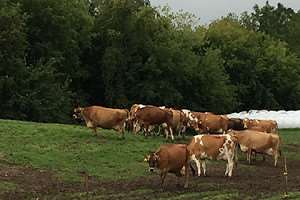Tracey Erickson
SDSU Extension Dairy Field Specialist
If you as a producer are considering fall grazing of your alfalfa field you will need to keep a few simple guidelines in mind. Bloat is probably the biggest concern with fall grazing of alfalfa, along with considerations given to potential crop injury via “winterization” or as it goes dormant. However, both are manageable, allowing producers to take advantage of this high quality grazing.

Why fall graze alfalfa?
Why fall graze alfalfa? By fall, most warm-season pastures have been utilized completely and/or the forage quality is low. Cool-season grass pastures will have some forage growth in the fall but usually less than alfalfa. Standing alfalfa can serve as an excellent protein supplement for livestock grazing adjacent crop residues such as cornstalks. Grazing alfalfa in late fall or winter can also reduce alfalfa weevil infestations by removing stems and plant parts that serve as a wintering site or spring laying site for weevil eggs.
Research in the north central U.S. has indicated that grazing may not interfere with the alfalfa going dormant. However, to minimize winter injury so there is adequate regrowth in the spring requires producers to graze lightly so that 6-8 inches of alfalfa regrowth remain.
When not to graze.
It is NOT recommended to move animals to alfalfa regrowth after a killing frost until 50-70% of the alfalfa top growth has been frozen and dried. Ruminants are most-susceptible to alfalfa bloat 3 to 5 days after a freeze. Frost may increase the incidence of bloat by rupturing plant cell walls, leading to a high initial rate of digestion. This causes gases to become trapped in the stable foam in the rumen which is produced from the digestion of the alfalfa instead of being released through the normal belching process of ruminant digestion. In the fall, bloat remains a potential problem when grazing alfalfa, especially when it is lush and immature, however it is minimized when the following guidelines are followed.
Click here to see more...